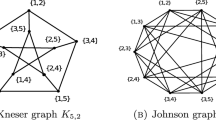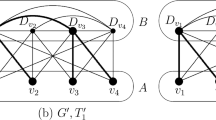Abstract
Let f be an integer-valued function defined on the vertex set V(G) of a graph G. A subset D of V(G) is an f-dominating set if each vertex x outside D is adjacent to at least f(x) vertices in D. The minimum number of vertices in an f-dominating set is defined to be the f-domination number, denoted by γ f (G). In a similar way one can define the connected and total f-domination numbers γ c,f (G) and γ t,f (G). If f(x) = 1 for all vertices x, then these are the ordinary domination number, connected domination number and total domination number of G, respectively. In this paper we prove some inequalities involving γ f (G), γ c,f (G), γ t,f (G) and the independence domination number i(G). In particular, several known results are generalized.
Similar content being viewed by others
References
R. B. Allan and R. Laskar: On domination and independent domination numbers of a graph. Discrete Math. 23 (1978), 73–76.
B. Bollobás and E. J. Cockayne: Graph-theoretic parameters concerning domination, independence and irredundance. J. Graph Theory 3 (1979), 241–249.
E. J. Cockayne, R. M. Dawes and S. T. Hedetniemi: Total domination in graphs. Networks 10 (1980), 211–219.
J. F. Fink and M. S. Jacobson: n-domination in graphs. Graph Theory with Applications to Algorithms and Computer Science. John Wiley & Sons, New York, 1985, pp. 283–300.
J. F. Fink and M. S. Jacobson: On n-domination, n-dependence and forbidden subgraphs. Graph Theory with Applications to Algorithms and Computer Science. John Wiley & Sons, New York, 1985, pp. 301–311.
J. E. Graver and M. E. Watkins: Combinatorics with Emphasis on the Theory of Graphs. Springer-Verlag, New York, 1977.
S. Hedetniemi, S. Hedetniemi and R. Laskar: Domination in trees: models and algorithms. Graph Theory with Applications to Algorithms and Computer Science. John Wiley & Sons, New York, 1985, pp. 423–442.
C. Stracke and L. Volkmann: A new domination conception. J. Graph Theory 17 (1993), 315–323.
J. M. Weinstein: On the number of disjoint edges in a graph. Canad. J. Math. 15 (1963), 106–111.
S. M. Zhou: On f-domination number of a graph. Czechoslovak Math. J. 46(121) (1996), 489–499.
S. M. Zhou and J. Y. Zhang: Invariants concerning f-domination in graphs. Combinatorics and Graph Theory '95. World Scientific, River Edge, NJ, 1999.
S. M. Zhou and X. N. Yue: Gallai-type equalities for f-domination and connected f-domination numbers. Graph Theory Notes of New York XXIX (1995), 30–32.
Author information
Authors and Affiliations
Rights and permissions
About this article
Cite this article
Zhou, S. Inequalities involving independence domination, f-domination, connected and total f-domination numbers. Czechoslovak Mathematical Journal 50, 321–330 (2000). https://doi.org/10.1023/A:1022470802343
Issue Date:
DOI: https://doi.org/10.1023/A:1022470802343




